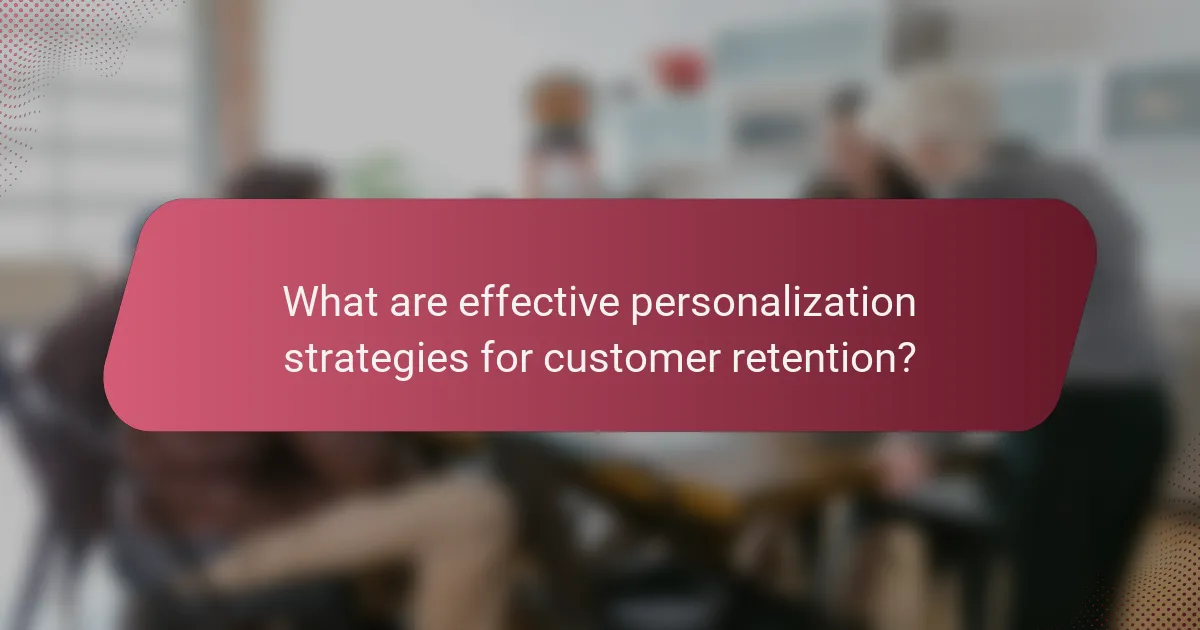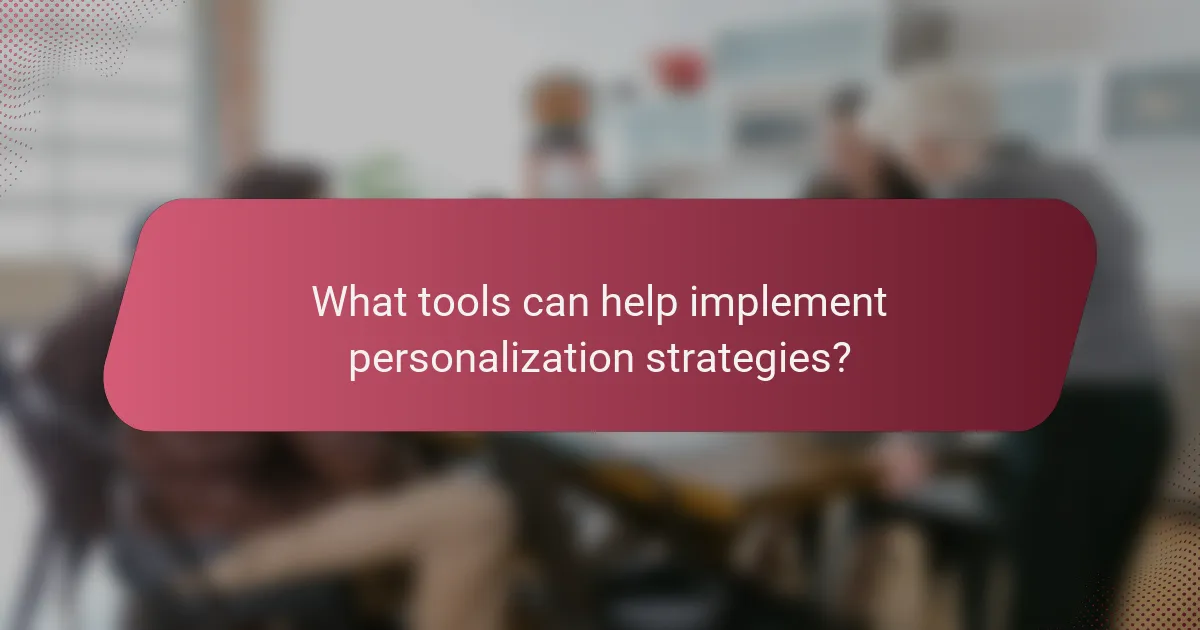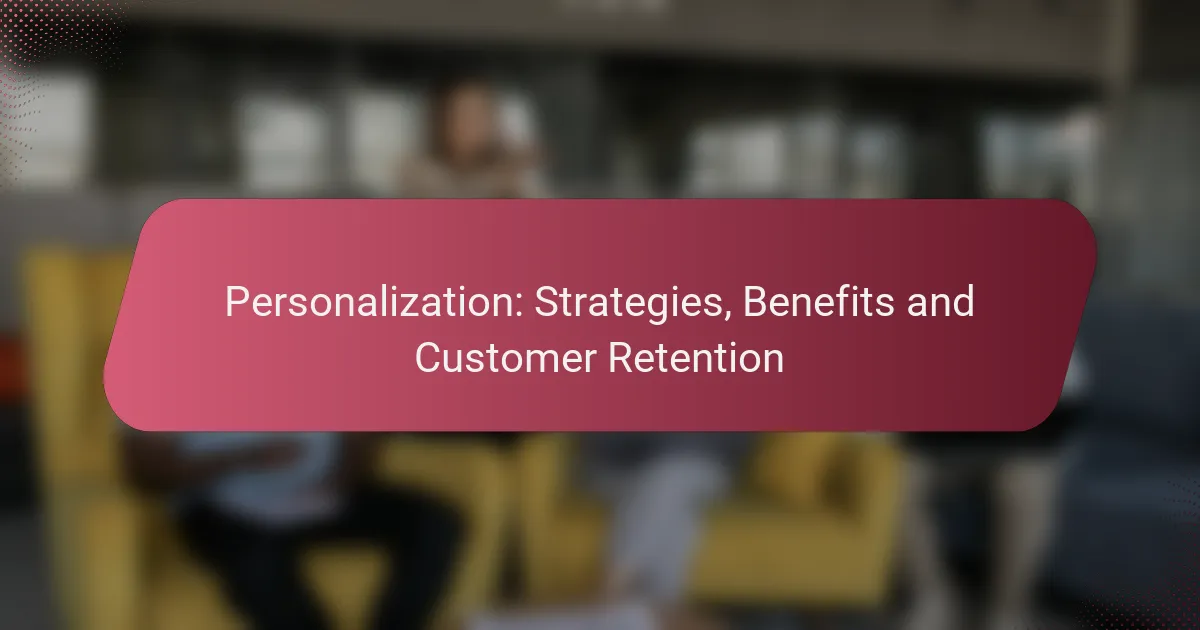Personalization is a powerful strategy for enhancing customer retention by customizing experiences and communications to align with individual preferences. By utilizing data and technology, businesses can create meaningful interactions that not only boost customer satisfaction but also foster loyalty and increase lifetime value.

What are effective personalization strategies for customer retention?
Effective personalization strategies for customer retention focus on tailoring experiences and communications to individual customer preferences. By leveraging data and technology, businesses can create more relevant interactions that foster loyalty and increase customer lifetime value.
Data-driven customer segmentation
Data-driven customer segmentation involves dividing your customer base into distinct groups based on shared characteristics, behaviors, or preferences. This allows businesses to target specific segments with tailored marketing efforts, increasing engagement and retention.
To implement effective segmentation, analyze customer data such as purchase history, demographics, and engagement metrics. Consider using tools like CRM systems or analytics platforms to identify trends and create actionable segments.
Personalized email marketing campaigns
Personalized email marketing campaigns utilize customer data to send tailored messages that resonate with individual recipients. These campaigns can include personalized product recommendations, special offers, or content based on past interactions.
To maximize effectiveness, segment your email list and craft messages that address the specific interests of each group. A/B testing can help refine your approach, ensuring that your emails achieve higher open and conversion rates.
Dynamic website content
Dynamic website content changes based on visitor data, providing a personalized experience that can significantly enhance user engagement. This can include tailored landing pages, product suggestions, or customized messaging based on user behavior.
Implementing dynamic content requires a robust content management system that can adapt in real-time. Ensure that your website tracks user interactions effectively to deliver relevant content that meets their needs.
Behavioral targeting in ads
Behavioral targeting in ads focuses on delivering advertisements based on users’ past online behavior. This strategy ensures that the ads shown are relevant to the individual’s interests, increasing the likelihood of engagement and conversion.
Utilize tools like Google Ads or social media advertising platforms to set up behavioral targeting. Monitor ad performance to adjust targeting parameters and improve the effectiveness of your campaigns.
Customized product recommendations
Customized product recommendations suggest items to customers based on their previous purchases and browsing behavior. This strategy not only enhances the shopping experience but also encourages repeat purchases, driving customer retention.
To implement effective recommendations, use algorithms that analyze customer data and predict preferences. Consider integrating recommendation engines into your e-commerce platform to automate this process and provide real-time suggestions.

How does personalization enhance customer experience?
Personalization enhances customer experience by tailoring interactions and offerings to individual preferences and behaviors. This approach fosters a deeper connection between brands and customers, leading to more meaningful engagement and satisfaction.
Increased customer engagement
Personalization significantly boosts customer engagement by providing relevant content and recommendations. When customers receive tailored messages, they are more likely to interact with the brand, whether through emails, social media, or website visits.
For example, an online retailer that suggests products based on past purchases can capture a customer’s interest more effectively than generic ads. This targeted approach can lead to higher click-through rates and more frequent visits.
Higher conversion rates
Personalization can lead to higher conversion rates by presenting customers with offers that resonate with their specific needs. When customers see products or services that align with their preferences, they are more inclined to make a purchase.
Research shows that personalized emails can achieve conversion rates that are significantly higher than standard emails. For instance, including a customer’s name and tailored product suggestions can increase the likelihood of completing a sale.
Improved customer satisfaction
Personalization contributes to improved customer satisfaction by making experiences more enjoyable and relevant. When customers feel understood and valued, their overall perception of the brand enhances, leading to loyalty.
Brands that utilize customer data to customize experiences often receive positive feedback. For example, a streaming service that recommends shows based on viewing history can create a more satisfying user experience, encouraging customers to remain subscribed longer.

What are the benefits of personalization in marketing?
Personalization in marketing offers significant advantages, such as improved customer engagement and higher conversion rates. By tailoring experiences to individual preferences, businesses can foster stronger relationships with their audience, leading to increased retention and sales.
Boosted customer loyalty
Personalization enhances customer loyalty by making consumers feel valued and understood. When customers receive recommendations or offers that align with their interests, they are more likely to return to the brand. For example, loyalty programs that reward personalized purchases can encourage repeat business.
To effectively boost loyalty, brands should utilize customer data to create tailored experiences. This can include personalized emails, targeted promotions, or customized product suggestions based on previous purchases.
Enhanced brand perception
When brands invest in personalization, they often see an improvement in how customers perceive them. A personalized approach signals that a brand cares about its customers, which can enhance trust and credibility. For instance, brands that address customers by name in communications tend to create a more intimate connection.
To enhance brand perception, businesses should focus on delivering consistent and relevant messaging across all channels. This includes social media, email, and in-store experiences, ensuring that every interaction reflects the brand’s commitment to personalization.
Increased average order value
Personalization can lead to an increase in average order value by encouraging customers to purchase more items. By suggesting complementary products or offering personalized discounts, brands can effectively upsell and cross-sell. For example, an online retailer might recommend accessories based on a customer’s previous purchases.
To maximize order value, businesses should analyze customer behavior and preferences to create targeted offers. Implementing strategies such as bundling products or providing personalized discounts can significantly impact overall sales performance.

What tools can help implement personalization strategies?
Implementing personalization strategies can be effectively supported by various tools designed for customer relationship management, data management, and website personalization. These tools streamline the process of gathering insights and tailoring experiences to individual customer preferences.
HubSpot for CRM and marketing automation
HubSpot offers a comprehensive CRM platform that integrates marketing automation features, allowing businesses to personalize their outreach based on customer interactions. By tracking user behavior and preferences, HubSpot enables targeted email campaigns and tailored content delivery.
To maximize HubSpot’s capabilities, ensure that you segment your audience based on relevant criteria such as demographics, purchase history, or engagement levels. This segmentation allows for more effective communication and increases the likelihood of conversion.
Segment for customer data management
Segment is a powerful tool for managing customer data across various platforms, providing a unified view of customer interactions. It collects data from multiple sources and allows businesses to create detailed customer profiles, which are essential for effective personalization.
When using Segment, focus on integrating it with your existing tools and platforms to ensure seamless data flow. Regularly update and clean your data to maintain accuracy, which is crucial for delivering personalized experiences that resonate with your audience.
Dynamic Yield for website personalization
Dynamic Yield specializes in website personalization by utilizing machine learning algorithms to tailor content and product recommendations based on user behavior. This tool helps create a unique browsing experience for each visitor, enhancing engagement and conversion rates.
To effectively implement Dynamic Yield, start by defining key performance indicators (KPIs) to measure the success of your personalization efforts. Test different variations of content and layouts to find the most effective combinations that drive user engagement and sales.

What metrics should be tracked for personalization success?
To measure personalization success, focus on metrics such as engagement rates, conversion rates, and customer retention. These indicators help assess how effectively personalized strategies resonate with customers and drive desired actions.
Engagement Rates
Engagement rates reflect how actively customers interact with personalized content or offers. Track metrics like click-through rates (CTR) and time spent on site to gauge interest. High engagement often indicates that your personalization efforts are relevant and appealing.
Conversion Rates
Conversion rates measure the percentage of users who complete a desired action, such as making a purchase or signing up for a newsletter. Monitor these rates before and after implementing personalization strategies to evaluate their impact. A noticeable increase in conversions can signal effective personalization.
Customer Retention
Customer retention rates indicate how well you keep customers over time. High retention suggests that personalized experiences foster loyalty. Consider tracking repeat purchase rates and customer lifetime value (CLV) to understand the long-term benefits of personalization.
Customer Feedback
Gathering customer feedback through surveys or reviews can provide qualitative insights into the effectiveness of your personalization efforts. Ask customers about their experiences and preferences to refine your strategies. Positive feedback often correlates with successful personalization.
Return on Investment (ROI)
Calculating ROI for personalization initiatives helps determine their financial effectiveness. Compare the costs of implementing personalized strategies against the revenue generated from increased sales or customer engagement. A positive ROI indicates that your efforts are worthwhile.
